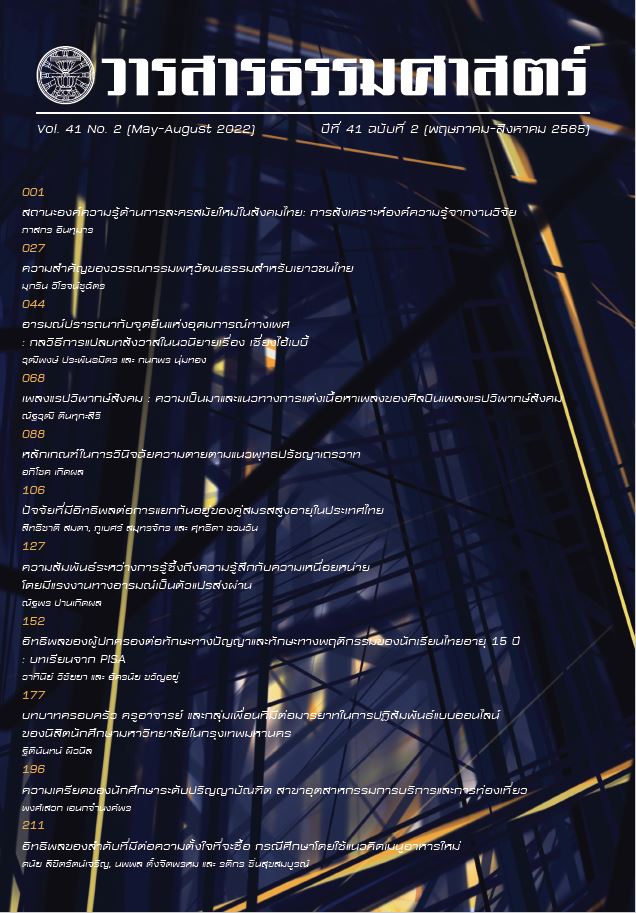Importance of Multicultural Literature for Young Thai Readers
Main Article Content
Abstract
This article aims to introduce multicultural literature as a genre of literature that tells the stories of culturally diverse groups that are dominated by more dominant groups (like people of color in the context of the White majority in the United States of America), in terms of its definition and historical background in order to emphasize its crucial role in empowering young readers to better understand and embrace the diversity in their societies. Books that depict culturally diverse groups in Thailand can be used as critical tools to help Thai youths better understand their culturally different compatriots. At the same time, these tools allow youngsters from specific cultural groups to see themselves in the books they read. Unfortunately, there are only a small number of books that can be referred to as multicultural literature when compared to the culturally diverse groups in the country. Moreover, among this small number of books, few of them empower young people and have them critically engage in social change. This article also calls attention to all the people who are involved in publishing books for young people and have them pay more attention to the production of high-value multicultural literature so that more tools to empower our children and youths to take action for social justice are available.
Article Details
References
ศิริจิต สุนันต๊ะ. (2556). สถานะการโต้แย้งเรื่องพหุวัฒนธรรมในประเทศไทย. วารสารภาษาและวัฒนธรรม, 32(1), 5-30.
Amazon. (n.d.). Retrieved 22 June, 2021, from https://www.amazon.com/s?k=the+five+chinese+brothers+childrens+book&i=stripbooks-intlship&crid=17GVDNXUC8CKG&sprefix=the+five+chi%2Cstripbooks-intlship%2C526&ref=nb_sb_ss_fb_1_12.
Amazon. (n.d.). Retrieved 22 June, 2021, from https://www.amazon.com/s?k=ten+little+rabits&crid=1SJ0E3C2LNQQ8&sprefix=ten+little+rabit%2Caps%2C407&ref=nb_sb_noss_2.
Bishop, R. S. (1990). Mirrors, windows, and sliding glass doors. Perspectives, 6(3), ix-xi.
Botelho, M. J. & Rudman, M. K. (2009). Critical multicultural analysis of children’s literature: Mirrors, windows, and doors. New York, NY: Routledge.
Cai, M. (2002). Multicultural literature for children and young adults. Westport, CT: Greenwood Press.
Ching, S. (2005). Multicultural children’s literature as an instrument of power. Language Arts, 83, 128-136.
Cooperative Children’s Book Center, School of Education, University of WisconsinMadison. (2021). Books by and/or about black, indigenous and people of
color (all years). Retrieved from https://ccbc.education.wisc.edu/literatureresources/ccbc-diversity-statistics/books-by-about-poc-fnn/.
Dubois, W. E. B. (2007). The soul of black folks. Oxford: Oxford University Press.
Foucault, M. (1983). Afterword: The subject and power. In H. L. Dreyfus & P. Rabinow, Michel Foucault: Beyond structuralism and hermeneutics. (2nd ed.) (pp. 208-226). Chicago, IL: The University of Chicago Press.
Gilton, D. L. (2007). Multicultural and ethnic children’s literature in the United States. Lanham, MD: The Scarecrow Press, INC.
Guinier, L & Torres, G. (2002). The miner’s canary: Enlisting race, resisting power. Cambridge, MA: Harvard University Press.
Henderson, D. L. (2005). Authenticity and accuracy: The continuing debate. In D. L. Henderson & J. P. May (Eds.), Exploring children and culturally diverse literature for children and adolescents (pp. 266-276). Boston, MA:Pearson.
Kiefer, B. Z. (2010). Charlotte Huck's children's literature. Boston, MA: McGraw-Hill.
Larrick, N. (1965). The all white world of children’s books. Saturday Review, 1, 63-65.
Amazon. (n.d.). Retrieved 22 June, 2021, from https://www.amazon.com/s?k=ten+little+rabits&crid=1SJ0E3C2LNQQ8&sprefix=ten+little+rabit%2Caps%2C407&ref=nb_sb_noss_2.
Bishop, R. S. (1990). Mirrors, windows, and sliding glass doors. Perspectives, 6(3), ix-xi.
Botelho, M. J. & Rudman, M. K. (2009). Critical multicultural analysis of children’s literature: Mirrors, windows, and doors. New York, NY: Routledge.
Cai, M. (2002). Multicultural literature for children and young adults. Westport, CT: Greenwood Press.
Ching, S. (2005). Multicultural children’s literature as an instrument of power. Language Arts, 83, 128-136.
Cooperative Children’s Book Center, School of Education, University of WisconsinMadison. (2021). Books by and/or about black, indigenous and people of color (all years). Retrieved from https://ccbc.education.wisc.edu/literatureresources/ccbc-diversity-statistics/books-by-about-poc-fnn/.
Dubois, W. E. B. (2007). The soul of black folks. Oxford: Oxford University Press.
Foucault, M. (1983). Afterword: The subject and power. In H. L. Dreyfus & P. Rabinow, Michel Foucault: Beyond structuralism and hermeneutics. (2nd ed.) (pp. 208-226). Chicago, IL: The University of Chicago Press.
Gilton, D. L. (2007). Multicultural and ethnic children’s literature in the United States. Lanham, MD: The Scarecrow Press, INC.
Guinier, L & Torres, G. (2002). The miner’s canary: Enlisting race, resisting power. Cambridge, MA: Harvard University Press.
Henderson, D. L. (2005). Authenticity and accuracy: The continuing debate. In D. L. Henderson & J. P. May (Eds.), Exploring children and culturally diverse literature for children and adolescents (pp. 266-276). Boston, MA:Pearson.
Kiefer, B. Z. (2010). Charlotte Huck's children's literature. Boston, MA: McGraw-Hill.
Larrick, N. (1965). The all white world of children’s books. Saturday Review, 1, 63-65.
Reese, D. (2007). A teacher reconsiders Virginia Grossman's ten little rabbits. American Indian in children’s literature. Retrieved from https://americanindiansinchildrensliterature.blogspot.com/2007/07/teacher-reconsidersvirginia-grossmans.html.
Saracho, O. N. & Spodek, B. (1983). Preface. In O. N. Saracho & B. Spodek, (Eds.), Understanding the multicultural experience in early childhood education. pp. vii-x. Washington, D. C.: National Association for the Education of Young Children.
Schwarz, A. V. (1977). The five Chinese brothers: Time to retire. Interracial Books for Children Bulletin, 8(3), 3–7.
Shannon, P. (1986). Hidden within the pages: A study of social perspective in young children's favorite books. The Reading Teacher, 39(7), 656-663.
Temple, C., Martinez, M. & Yokata, J. (2015). Children’s books in children’s hands: A brief introduction to their literature (5th ed.). Upper Saddle River, NJ: Pearson.
Trites, R. S. (2000). Disturbing the universe: Power and repression in adolescent literature. Iowa City, IA: University of Iowa Press. We Need Diverse Books TM (WNDB). (n.d.). Retrieved fromhttps://diversebooks.org/.
Wirojchoochut, M. (2020). Reading power in Thai young adult realistic fiction: Understanding ethnicity, class, and gender (Unpublished doctoral dissertation). University of Massachusetts Amherst.

